After a dramatic two-year property boom, what next for Hungary?
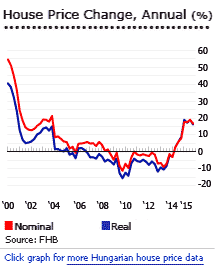 Hungary has experienced an amazing property bull market for the past two years, but a slowdown appears imminent.
Hungary has experienced an amazing property bull market for the past two years, but a slowdown appears imminent.
During 2015 house prices increased by 17.71% (17.78% inflation-adjusted), according to FHB Bank's estimate. Figures from the Hungarian Central Statistical Office (KSH) are lower - according to KSH, prices of existing dwellings rose by 11.71% (11.78% inflation-adjusted) in 2015, while prices of new dwellings increased by 6.67% (6.74% inflation-adjusted).
In Budapest, Hungary's capital, the mean price of existing and new dwellings increased by 15.53% (14.93% inflation-adjusted) y-o-y in Q4 2015, according to KSH.
In 2015, credit for second-hand homes rose by 36.5%. Dwelling permits issued were up 38.8% y-o-y during the first quarter of 2016 - boomtime growth figures!
However, although total housing transactions rose by 4.9% in 2015, most growth took place in the first half of the year and was concentrated in second hand homes. A slowdown appears imminent. In Q1 2016, Hungary's GDP slowed sharply with only 0.9% growth y-o-y, the slowest for three years, according to the Hungarian Central Statistical Office (KSH). The meagre expansion was due to weak construction and weak industrial growth. The OECD lowered this year's economic outlook for Hungary from 2.4% to 1.6%.
Obviously Hungarian real estate agents were very happy in 2015! During the first nine months of 2015, selling times plunged in comparison to the same period in 2014, according to Otthon Centrum (OC).
- Blockhouse flats required 1.5 months to sell on average, 43.37% less than in 2014.
- Brick-built flats required 3 months to sell on average, 27.64% lower.
- Brick-built family homes required 7.5 months to sell on average, down by only 1.35%.
Part of the recovery in housing demand 2014-5 was caused by the government increasing, at the beginning of 2013, the amount of 5-year loan subsidies, the maximum value of subsidized loans, and the loan house price threshold. These measures causing significantly stronger credit demand in the second half of 2013. Demand continued to rise in 2014 and 2015, according to KSH.
A non-refundable subsidy, the family housing allowance (CSOK) became available from July 1, 2015. It can be used for buying new- and used homes, for apartment expansions, and for home construction.
On December 15, 2015, the National Assembly lowered the VAT rate for new dwelling units to 5% from the previous 27%, in a further attempt to boost the property market. The new VAT rate will be effective from 2016 to 2019. The amendment also contained other measures to improve construction sector's performance and reduce red tape, according to the Ministry for National Economy.
Purchases of real estate in Hungary by foreigners
Hungarian law requires that real estate purchases shall be concluded through private contract (purchase agreement) countersigned by a lawyer. Non-Hungarian citizens are further obliged to gain the approval of the relevant Administrative Office in order to purchase property as a private person. According to regulations most foreigners should receive a permit within 2-3 months.
Most lawyers advise foreign nationals to set up a company registered in Hungary in order to purchase property. In this case, no permit is needed. This is a fairly swift and easy procedure (taking 1-2 days), and all expenses can be written off.
Property market history
During Hungary’s housing boom (1998-2007), house prices soared by 264% (102% inflation-adjusted). However, the market started to fall in 2008, mainly due to the global financial meltdown. Real house prices started to rise again in 2014.
Dwelling prices in Budapest dropped significantly between 2008 and 2013, according to KSK:
- In 2008, dwelling prices rose by 2.51% y-o-y (-1.66% inflation-adjusted)
- In 2009, dwelling prices sharply fell by 11.12% y-o-y (-15.52% inflation-adjusted)
- In 2010, welling prices rose by 2.19% y-o-y (-2.04% inflation-adjusted)
- In 2011, dwelling prices declined by 2.38% y-o-y (-6.22% inflation-adjusted)
- In 2012, dwelling prices fell by 5.86% y-o-y (-10.68% inflation-adjusted)
- In 2013, dwelling prices dropped by 2.61% y-o-y (-3.33% inflation-adjusted)
- In 2014, dwelling prices rose by 10.71% y-o-y (11.48% inflation-adjusted)
- In 2015, dwelling prices sharply rose by 15.53% y-o-y (14.93% inflation-adjusted)
AVERAGE PRICE PER SECONDHAND DWELLING |
||||||||
| Detached | Condominium | Housing Estate | Total | |||||
| 2014 | 2015. I–IV. | 2014 | 2015. I–IV. | 2014 | 2015. I–IV. | 2014 | 2015. I–IV. | |
| Central Hungary | HUF 18.1 million (US$ 63,972) |
HUF 18.5 million (US$ 65,386) |
HUF 14.2 million (US$ 50,188) |
HUF 16.6 million (US$ 58,671) |
HUF 10.1 million (US$ 35,697) |
HUF 12.1 million (US$ 42,766) |
HUF 14.4 million (US$ 50,895) |
HUF 16.3 million (US$ 57,610) |
| Central Transdanubia | HUF 9.9 million (US$ 34,990) |
HUF 10.2 million (US$ 36,051) |
HUF 7.6 million (US$ 26,861) |
HUF 8.3 million (US$ 29,335) |
HUF 6.6 million (US$ 23,327) |
HUF 7.6 million (US$ 26,861) |
HUF 8.7 million (US$ 30,749) |
HUF 9.2 million (US$ 32,516) |
| Western Transdanubia | HUF 10.0 million (US$ 35,344) |
HUF 10.5 million (US$ 37,111) |
HUF 10.3 million (US$ 36,404) |
HUF 11.1 million (US$ 39,232) |
HUF 9.0 million (US$ 31,809) |
HUF 11.3 million (US$ 39,938) |
HUF 10.1 million (US$ 35,697) |
HUF 10.8 million (US$ 38,171) |
| Southern Transdanubia | HUF 7.6 million (US$ 26,861) |
HUF 8.0 million (US$ 28,275) |
HUF 7.8 million (US$ 27,568) |
HUF 8.2 million (US$ 28,982) |
HUF 6.6 million (US$ 23,327) |
HUF 7.2 million (US$ 25,448) |
HUF 7.5 million (US$ 26,508) |
HUF 7.9 million (US$ 27,922) |
| Northern Hungary | HUF 5.7 million (US$ 20,146) |
HUF 5.7 million (US$ 20,146) |
HUF 6.4 million (US$ 22,620) |
HUF 7.0 million (US$ 24,741) |
HUF 4.5 million (US$ 15,905) |
HUF 5.0 million (US$ 17,672) |
HUF 5.6 million (US$ 19,793) |
HUF 5.9 million (US$ 20,853) |
| Northern Great Plain | HUF 5.8 million (US$ 20,499) |
HUF 6.1 million (US$ 21,560) |
HUF 8.4 million (US$ 29,689) |
HUF 9.0 million (US$ 31,809) |
HUF 7.8 million (US$ 27,568) |
HUF 9.1 million (US$ 32,163) |
HUF 6.8 million (US$ 24,034) |
HUF 7.3 million (US$ 25,801) |
| Southern Great Plain | HUF 6.2 million (US$ 21,913) |
HUF 6.7 million (US$ 23,680) |
HUF 8.0 million (US$ 28,275) |
HUF 8.7 million (US$ 30,749) |
HUF 5.9 million (US$ 20,853) |
HUF 6.6 million (US$ 23,327) |
HUF 6.8 million (US$ 24,034) |
HUF 7.4 million (US$ 26,154) |
| Hungary (whole) | HUF 9.6 million (US$ 33,930) |
HUF 9.9 million (US$ 34,990) |
HUF 11.6 million (US$ 40,999) |
HUF 13.1 million (US$ 46,300) |
HUF 8.2 million (US$ 28,982) |
HUF 9.5 million (US$ 33,577) |
HUF 10.3 million (US$ 36,404) |
HUF 11.3 million (US$ 39,938) |
| Source: KSH | ||||||||
Moderate to good rental yields
Gross rental yields in Budapest range from moderate to good. In Buda, Budapest's greener side, apartments have relatively higher yields ranging from 6.64% to 6.98%, with smaller apartments yielding more than larger ones, based on Global Property Guide research in July 2015. Apartments in Pest, Budapest’s business and commercial centre, have slightly lower rental yields ranging from 4.75% to 6.15%.
In Buda, monthly rents range from EUR 9 (US$ 10.14) to EUR 10 (US$ 11.27) per sq. m. Meanwhile in Pest, apartments can be rented from almost EUR 10 (US$ 11.27) to EUR 11 (US$ 12.39) per sq. m. per month.
There was a significant rise in rents in the first nine months of 2015, according to Otthon Centrum (OC). OC noted that the rise of rents were fuelled by higher consumer confidence of households and execution of postponed moves.
Average monthly rent per square metre: |
||||||
| Type of second hand property | 2010 | 2011 | 2012 | 2013 | 2014 | Q1-Q3 2015 |
| Brick built flats | HUF 1,390 (US$ 5.04) | HUF 1,310 (US$ 4.75) | HUF 1,370 (US$ 4.97) | HUF 1,440 (US$ 5.22) | HUF 1,480 (US$ 5.37) | HUF 1,900 (US$ 6.89) |
| Blockhouse flats | HUF 930 (US$ 3.37) | HUF 970 (US$ 3.52) | HUF 1,000 (US$ 3.63) | HUF 1,070 (US$ 3.88) | HUF 1,150 (US$ 4.17) | HUF 1,400 (US$ 5.08) |
| Brick built family homes | HUF 970 (US$ 3.52) | HUF 970 (US$ 3.52) | HUF 960 (US$ 3.48) | HUF 1,000 (US$ 3.63) | HUF 1,040 (US$ 3.77) | HUF 1,140 (US$ 4.13) |
| Source: Otthon Centrum | ||||||
Declining interest rates
Housing loan interest rates in Hungary are still falling. In Q4 2015, average APRs on housing loans were 5.81%, 0.9% down on the 6.68% rate prevailing in Q4 2014, according to the Hungarian National Bank (MNB).
Average interest rates on loans for house purchases in April 2016:
- Floating rate, or with IRF up to 1 year ― 4.12%
- IRF over 1 year and up to 5 years ―5.91%
- IRF over 5 and up to 10 years ― 5.60%
- IRF over 10 years ―5.49%
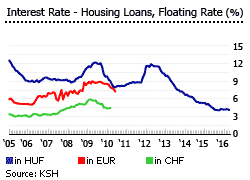
Despite declining interest rates, the household sector was still s net repayer in September 2015, with HUF 21.2 billion (US$ 76.5 million) more repayments than new loans, according to the MNB. The household sector is expected to remain being a net loan repayer until early 2017, according to the MNB.
According to Otthon Centrum, the drop in the average cost of loans, already at a 10-year low in Q3 2015, may boost the demand for housing loans.
Nevertheless in 2015, the total amount of mortgage loans fell by almost 10%, after a slight increase of 0.2% in 2014. The decline of loans in 2015 was due to the decrease in foreign currency loans of around HUF 1,732 billion (US$ 6.20 billion), which exceeded an increase of HUF 1,405 billion (US$ 5.03 billion) in forint loans, according to the Hungarian Central Statistical Office's (KSH) report on residential mortgages for 2015.
VAT has been cut on newbuild homes
VAT on newly-built homes has been cut, in a measure which will only last between 2016 and 2019 - from 27% to 5%. This is likely to increase supply.
While the newly-built homes market improved during the first three quarters in 2015, newly-built homes accounted for only around 2.79% of total home sales (4.22% in Budapest), according to Otthon Centrum (OC) - still marginal, compared to their 9.15% share of total sales in 2008 (14.39% in Budapest).
Transactions of new homes plunged by 55.7% during the year to Q4 2015, and by 69.3% y-o-y in Budapest, according to the Hungarian Central Statistical Office (KSH). For the whole year of 2015, housing credits for new dwellings fell by 8.54%, down by 89.13% from the 2004 peak.
Why the decline? Although 15% of Otthon Centrum's Budapest clients were looking newly-built flats (10% in the countryside), they were not happy with the existing "static, pre-picked stock of [new] homes", said Attila Déry of Otthon Centrum, given that the stock of unsold newly-built homes has continuously declined. With VAT still at 27% in 2015 investment returns were low, and no major investments were launched despite growing demand.
In response, the government temporarily lowered the VAT rate.
NUMBER OF SALE TRANSACTIONS |
||||||||
| 2008 | 2009 | 2010 | 2011 | 2012 | 2013 | 2014 | 2015 estimate | |
| Homes for resale | 140,000 | 82,900 | 85,500 | 83,900 | 83,323 | 86,418 | 110,480 | 150,000 |
| New homes | 14,100 | 8,300 | 4,800 | 3,900 | 2,634 | 2,295 | 3,309 | 4,300 |
| Homes for resale, Budapest | 34,504 | 20,674 | 24,714 | 22,578 | 23,916 | 25,275 | 34,130 | 50,300 |
| New homes, Budapest | 5,798 | 3,064 | 2,015 | 1,551 | 1,124 | 1,043 | 1,450 | 2,214 |
| Share of new homes in sales | 9.15% | 9.10% | 5.32% | 4.44% | 3.06% | 2.59% | 2.91% | 2.79% |
| Share of new homes in sales, Budapest | 14.39% | 12.91% | 7.54% | 6.43% | 4.49% | 3.96% | 4.08% | 4.22% |
| Source: KSH, Otthon Centrum | ||||||||
More building permits are being issued
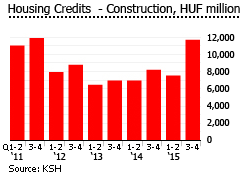
This policy has already had significant results. The number of residential permits issued rose by 38.8% to around 1,715 during the year to March 2016. In 2015, the number of permits issued had already increased by 27.2% to 6,526.
In Budapest, the number of residential permits issued during the first quarter of 2016 was almost double that in Q1 2015, rising by 95.3% y-o-y to 293. The number of permits issued for non-residential buildings were also up by 46% to 1,266.
| Number of Construction permits issued | Number of dwellings built | |||
| Q1 2015 | Q1 2016 | Q1 2015 | Q1 2016 | |
| Budapest | 720 | 1,280 | 516 | 419 |
| County towns | 530 | 1,296 | 332 | 456 |
| Other towns | 703 | 1,505 | 421 | 355 |
| Villages | 428 | 684 | 303 | 177 |
| Hungary (whole) | 2,381 | 4,765 | 1,572 | 1,407 |
| Source: KSH | ||||
Half of all new dwellings are located in Budapest and Pest County, according to KSH.
Built Dwellings, annual change (%) 2015 |
|||
| For own use | For lease | For sale | |
| Budapest | 2.89 | -67.62 | 3.78 |
| County towns | -7.60 | 36.00 | -21.97 |
| Other towns | -15.61 | 126.32 | -9.88 |
| Villages | -9.22 | 215.00 | 33.33 |
| Hungary (whole) | -9.61 | -14.33 | -7.77 |
| Source: KSH | |||

Housing credits and subsidies transferred for construction rose by 42.5% during the second half of 2015 (Q3- Q4 2015).
The mortgage crisis is over
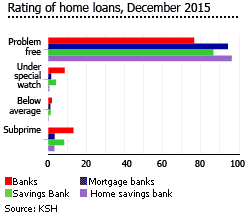
Hungary’s residential mortgage market ground to a halt in 2009 as a result of the decline in the value of the Forint against the Euro. A large portion of mortgages were backed by foreign currency loans, burdening homeowners with swelling repayments, and prompting buyers to exit the market.
Foreign currency mortgages were banned in August 2010, and a number of measures were introduced to manage the foreign currency loan crisis:
- an early repayment scheme
- exchange rate fixing
- foreclosure quota
- home protection interest subsidy
- establishment of the National Asset Management Company
The introduction of an early repayment scheme in September 2011 unilaterally changed the terms of all foreign currency loan contracts and allowed debtors to make a one-off repayment of their loans at a discounted exchange rate. Banks had to cover the difference between the discounted exchange rate and the current exchange rate.
Those unable to afford early repayment of foreign currency loans have been able to get help since 2012 by paying the instalments at a fixed exchange rate. Nearly 173,000 contracts for the fixed-rate payment scheme had been concluded by October 2014, according to the Hungarian National Bank (MNB).
As of December 2015, only 0.2% of the stock of housing loans was in foreign currency, down from 52% in December 2014. Legislation adopted in November 2014 requires financial institutions to convert all outstanding foreign currency-denominated loans into HUF claims.
The National Asset Management Zrt purchased properties of debtors unable to pay mortgages, allowing debtors to continued use of these properties as tenants. Around 19,628 collateralized properties were purchased from January 2013 to December 2015.
One sign that the crisis is over is that from January 1, 2015 creditors have been allowed to sell any non-performing residential real estate, without restriction. From October 2011, the government had limited banks to designating 2% of homes in non-performing portfolios as "for sale". The quota rose to 3% per quarter in 2012, to 4% per quarter in 2013, and to 5% in 2014.
As of December 31, 2015, around 85.7% of current loans were "problem free" (7.2 percentage points higher than at year-end 2014), while 4.8% were "under special watch". About 1.3% of the total current loans were "below average", and "sub-prime" (consisting of doubtful and bad loans) had an 8.2% share.
Hungary's economy to slow in 2016
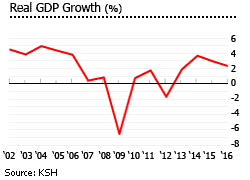
There was good growth in Hungary in 2015, with GDP expanding by 2.9%, well above the euro area's (1.6%) and the European Union's (1.9%) growth rates. The recent growth was lower than the 3.7% growth in 2014, but still an improvement from 1.9% in 2013 and a 1.7% contraction in 2012.
Growth was fueled by lower oil prices, which boosted domestic demand. There was high private consumption (3.2% y-o-y growth), increased fixed investment (6.5% y-o-y growth), and higher government consumption (6.7% y-o-y growth).
However in Q1 2016, Hungary's GDP growth sharply slowed to 0.9% y-o-y, the slowest in three years, according to the Hungarian Central Statistical Office (KSH), due to weak construction spending and weak industrial growth. The OECD lowered this year's economic outlook from 2.4% to 1.6%, although the OECD retained its 3.1% prediction for 2017.
From 1997 to 2006 Hungary enjoyed robust economic growth of about 4% per annum. Then in 2007 growth slowed sharply to 0.43%, and 0.84% in 2008. In 2009 GDP shrank by 6.6%, Hungary´s worst economic contraction since 1991. In October 2008 the government was forced to ask the International Monetary Fund (IMF) and the European Central Bank (ECB) for a rescue package worth US$25 billion to prevent the Hungarian economy from collapsing.
The economy returned to growth in 2010, with growth rates of 0.7% in 2010 and 1.8% in 2011. However it contracted again by 1.7% in 2012, amidst high debt, high unemployment and the Eurozone debt crisis.
By 2015, Hungary's fiscal deficit was only 1.9% of GDP, after deficits of 2.3% in 2014, 2.6% in 2013, and 2.3% in 2012. Hungary's credit rating was upgraded by Fitch Ratings to "investment grade" in May 2016, raising its long-term rating from BB+ to BBB- and with a stable outlook.
"We expect a similar positive decision by the other two main rating companies after the upgrade by Fitch, " said Hungary's Economy Minister Mihaly Varga.
Hungary's unemployment rate in Q1 2016 was 6%, a decline from 7.8% the same quarter last year. in April 2016, consumer price in the country rose by 0.2% y-o-y.
Orban´s authoritarianism remains popular
Despite being accused of authoritarianism by some groups and countries, including the European Union and the United States, recent economic growth has boosted the popularity of Prime Minister Viktor Orban and his government, propelling him and his party, Fidesz (the Hungarian Civic Union) to victory in the 2014 elections. Fidesz, a national conservative political party, won 133 seats, followed by Unity with 38 seats, Jobbik with 23 seats, and LMP with 5 seats.
During Orban’s second term as prime minister, his government was able to alter the National Constitution, reducing the number of Members of the Parliament (MPs) from 386 to 199.